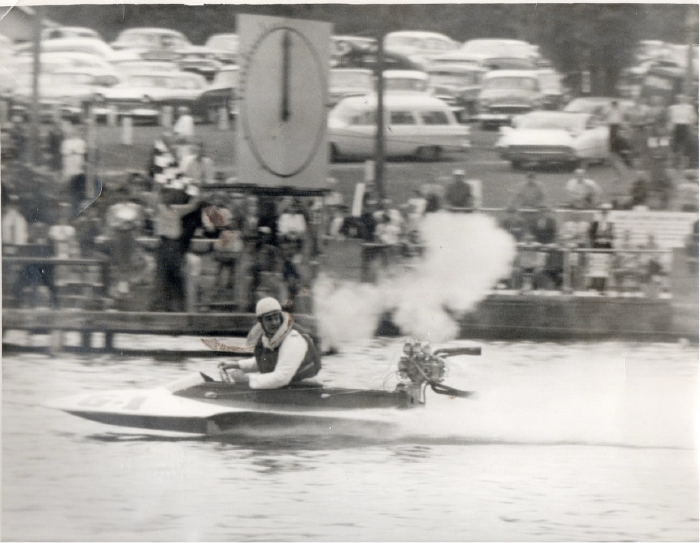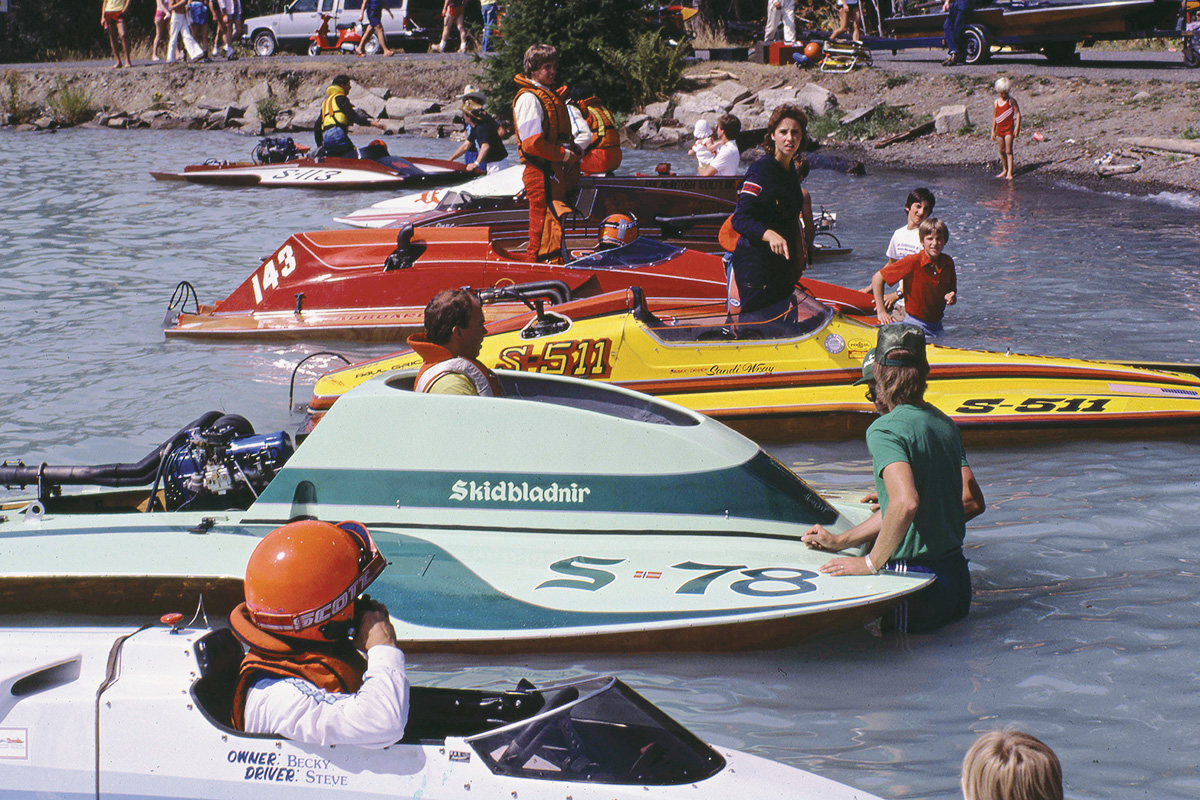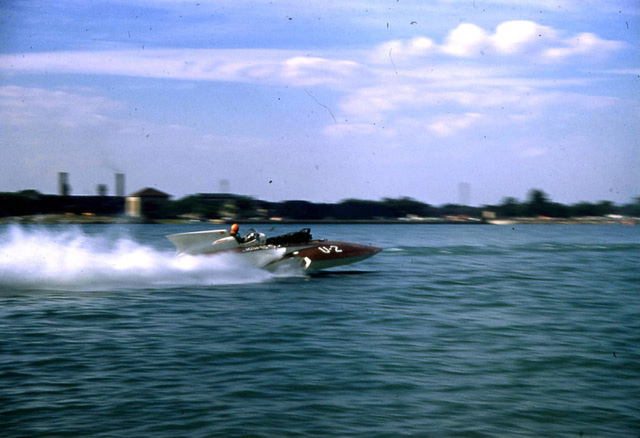An Interview with Earl Wham
September 23, 2021 - 10:43pm
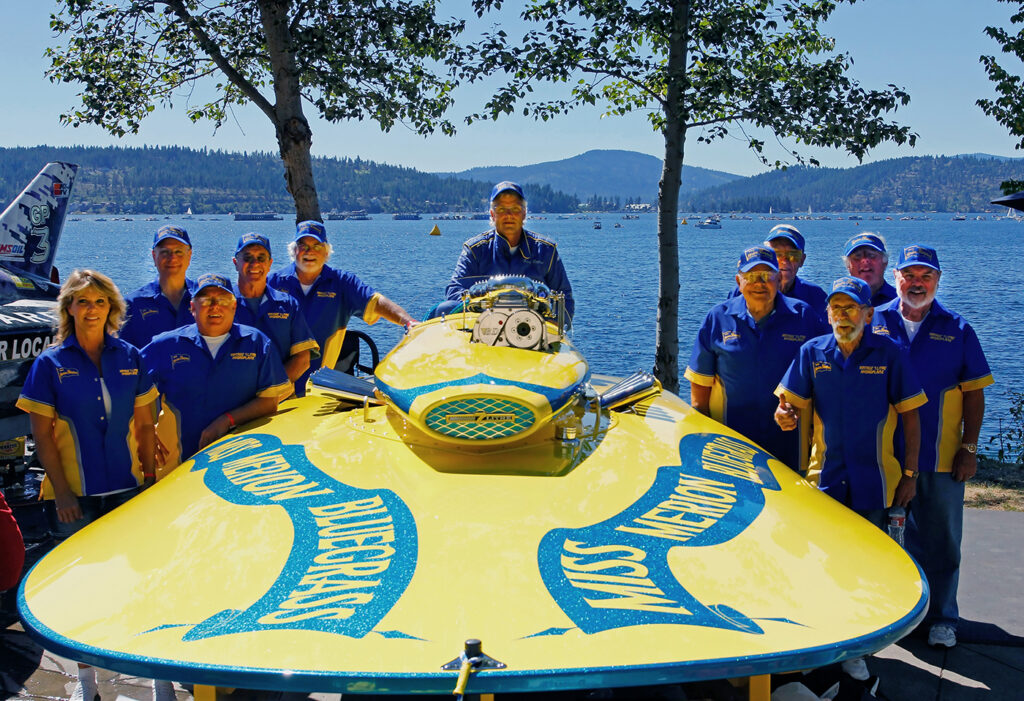
Earl Wham, center, with the Miss Merion Bluegrass team at Coeur d’Alene, Idaho, in 2013 (the boat was running in vintage events at that time). Courtesy of Gleason Racing Photography
By Craig Fjarlie
Earl T. Wham was a champion inboard driver during the 1960s and early ‘70s. He competed in the 266 and 7-Litre classes, where he won numerous races and set course records. Wham was born in the small town of Republic, Washington, on January 13, 1931. His father took a job working on Grand Coulee Dam. Later the family moved to Spokane, where Wham started racing stock cars. While racing, he worked for AT&T as a digital repairman. “When anything went wrong with any digital line, I went out and fixed it,” he explains. “Day or night, I was on call for 24 hours a day.” Wham retired from racing, and from the phone company. He died on March 2, 2018. The following interview was conducted at Lake Chelan, Washington, on October 5, 2013, during the Hydroplane and Race Boat Museum’s Mahogany & Merlot event.
What was your first involvement with racing?
When I was 18 years old I went to a stock car race. That was pretty exciting in those days. I thought, “I can drive better than any of those guys.”
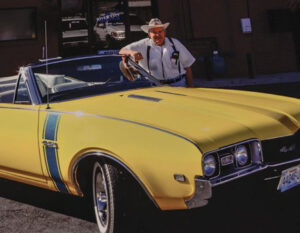
Earl never lost his love of horsepower.
This was in Spokane?
Yeah, on a 5/8-mile dirt track. One of the fastest tracks in the Northwest. The only thing I knew about racing was what I’d seen of Mickey Rooney and Clark Gable (laughter). People said that race drivers always drove wide open, so I drove wide open. I didn’t know any difference. I’d never talked to anybody and built my own race car. Took it to the racetrack, raced it wide open. First eight races I was in, I rolled over nine times! Nine separate times. Got the car fixed up, came back, still tried to go wide open. I eventually did go wide open around that track and I set a track record that was never beaten. That track closed down and nobody ever surpassed it.
Was there a specific class you raced in?
It was all hardtop, late model racing in the ‘50s. I raced there for six years. I was number two twice and number one twice. We raced another track, a quarter-mile dirt, and I set a track record there that was never beaten. They quit racing and I still had the record. The same thing happened on the 5/8. I won so many races they outlawed my engine.
What kind of car were you racing, what brand?
Chevrolet—well, GMC engine.
Were you doing your own mechanical work too, then?
No, I worked with a guy by the name of Fred Rogers. Same guy whose son, named Kirk, built (the vintage) Miss Merion Bluegrass. In 1956 I won over three-quarters of the races and they outlawed my Chevrolet V-8 engine. It was a 265. So I looked around for a place to put the engine and there was a 266 hydroplane class. So I bought a used hydroplane and put my engine in there, but it was so powerful that every time I ran it, it stripped the hull, literally, to the point where all the screws fell out. We literally were haywiring it to hold it together.
You started in 266? That’s a pretty fast class.
Yeah, I was second fastest at the time.
Who did you buy the boat from?
Cliff Carl, a musician in Spokane. (Carl also appeared on KHQ-TV in Spokane – Ed.)
Do you know who built the boat?
I don’t remember that. What I remember is the boat disintegrated at Electric City and all I had left was the engine.
What was the name of your first boat?
Squirrel, because it was so squirrelly. It was a cabover. The cabover part of it came loose, came up, and hit me on top of the head. I had all kinds of trouble with that. So, I had that engine sittin’ there and I got to talking with a drag racer, and we built a twin-engine dragster. We ran that in 1959 and won 10 or 12 races with it. But I never liked drag racing, so I took my engine and quit racing ‘em. In 1959 I found this boat. Holy Smoke it was called. A guy by the name of Fred Prindle, who was vice-president over at Bunker Hill mine, spent three years building this Holy Smoke hydroplane. It was an immaculate boat, just absolutely out of this world. He threw a big dinner with 700 dancing and all that. Then he took 40 or 50 people out and showed them his boat. He kind of took me aside and he said, “We built this boat to race but none of us can drive it. We’d like you to buy it and take over driving it.” I said, “How much you got in it?” He says, “Oh, around $10,000.” Well, $10,000 was like a million to me today. He just wanted to race. So I said, “There’s no way I can do it,” and I left. I went skiing and broke my leg. I had a walking cast on so I was working with Fred Rogers. He was hauling his farm equipment, motors, and all of that in his John Deeres. Little bit of coercion and talking about this beautiful boat. He’d worked with me on the race car and knew what kind of driver I was. Well, anyway, finally talked him into going up to Bunker Hill and looking at this boat. When we saw it, we both fell in love.
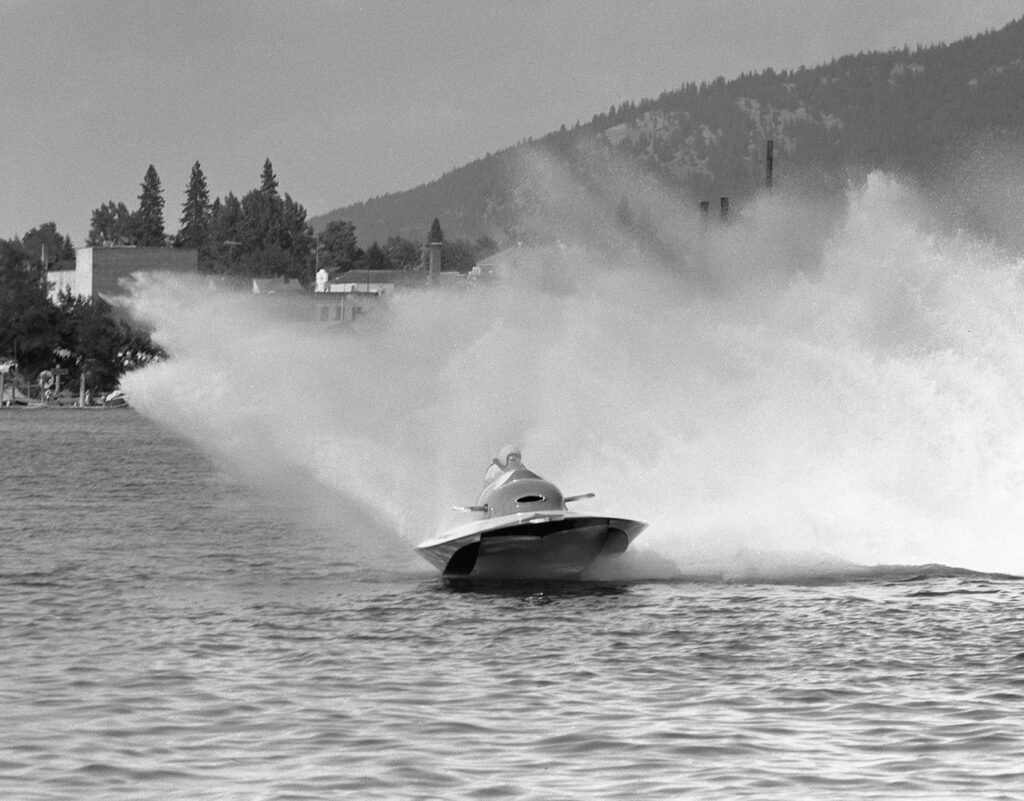
Earl Wham’s 266 boat Holy Smoke, powering through a turn. Photo from the Bob Carver collection.

The 266 Holy Smoke, center, in competition. Photo from the Bob Carver collection.
And what class was it?
It was built for 266. Like I said, Fred Prindle said he had $10,000 in it. That was like a million dollars to me. One thing led to another and he said, “Could you come up with $2,000?” We talked it over and Fred said he could come up with $500 and I could come up with $500. I said, “We’ll give you $1,000 and we’ll owe you $1,000.” It had an engine and a gearbox in it, and I said, “When we sell this engine that’s in it and the gear box, we’ll give you the other $1,000.” That took three years for us to do. He said, “This boat will break the world record.” Well, everybody that builds a boat thinks it’s gonna be the fastest in the world, I don’t care what kind of boat it is. So he said, “Just go out and break the world record.” To make a long story short, I won 100 races with it. And we finally sold that engine and got him his thousand dollars, got it all paid off. At Poulsbo in 1962, I believe, ’61, I broke the world course record in Holy Smoke. I got the certificate from UIM. I got a copy of that world record and took it up to Fred Prindle and he almost cried. He says, “I knew this boat would break a world record and I knew you guys would do it.”
So that gave us the world course record in the 266 class. In the meantime, we’d been racing the 266 against 7-Litres in free-for-alls and I’d been consistently beating them. Along comes the Diamond Cup in 1963 and it was a free-for-all. Any boat that anybody wanted to enter could enter, and I won the Little Diamond Cup in ’63 with the 266, running against the 7-Litres on the Diamond Cup race course in Coeur d’Alene, Idaho.
Same course the Unlimiteds used?
No, they had a shorter course laid out, and we won. Anyway, we separated from the 266 class after that. In 1964 the Little Diamond Cup was 7-Litres only. So I bought Miss Merion Bluegrass from this guy by the name of Kenny Kimbrough, who wasn’t racing. He said, “This boat’s very close to breaking a world record.” But it was in terrible shape.
Had he run it before and not taken care of it?
He had run it before and got married and couldn’t afford to race it. Sat for a couple years in his garage with oil in it and everything.
Who built the boat?
Kimbrough.
He built it himself?
Yes. He built it three miles down the road from where my shop was out in the valley. I’d work on my boat, the Holy Smoke, and I’d stop by and see what he was doing. I talked him into putting in reinforcements. It called for 14 battens, we put in 21. Things like that. Reinforcing…
It was stout.
Stout, yeah, ‘cause he’d had trouble with his boats breaking up like I had with mine. You know, we drove ‘em hard and they weren’t built strong, really. Anyway, he raced it for a while, never had any luck, never won a single race with it. But it looked like it might want to run. When he got transferred on his job to Lewiston, he had to get rid of the boat out of the garage. He offered to sell it to me for $2,000 with no engine; trailer and everything, travel trailer. “I ain’t got $2,000, I’ll give you $900.” When it got down to $900 I said, “I’ll give you $300 now and the other $600 when I get it.” He said, “Well, I gotta get this boat out of here since they’re moving, so you come out and get it.” About three years later I got the other $600 paid off. I didn’t have any money. So I was working on the boat all the time getting it ready while I was running the Holy Smoke. The Holy Smoke was doing real well, I was happy with it. Now comes this race, the Little Diamond Cup. All they had on the sanction was 7-Litres only. I had the 266. I just finished overhauling the engine a week before the race. I had it hanging over the Holy Smoke. I was going to put it in the Holy Smoke and go up to Coeur d’Alene and do a little politicking and spectating. Anyway, Kenny came up from Lewiston on Monday and we went out for coffee together. He says, “They got that big race in Coeur d’Alene, you know.” I said, “Yeah, but I ain’t got no…” He says, “You got my boat. You used to beat it with the Holy Smoke engine. Put the Holy Smoke engine in it, go out and beat ‘em again.” “Aw, it’s a two-mile course, Kenny, it’s the biggest course I ever raced on in my life.” He says, “Well, I guess you’re right.”
I thought about it the rest of the day. Finished up and got off work at 4:30, stopped at the hardware store. Bought $100 worth of fittings and pipes and hoses. Went out there and started working. In five days I fitted that engine in there. Got everything done but the painting. That boat was eight different colors. It was pink, green, clear, brown, mahogany, and red. I sanded on it to do the colors on the cowling, but we didn’t worry about that. I just put it on the trailer, went out and ran that night. Tried two different propellers on it. Went out for the race. These 7-Litre guys had been out there all week testing on the course. Had their boats all ready to go. They really had ’em going. Come down for the start. I kept on it, was a quarter of a lap ahead going into the first corner. All of a sudden the red flag comes out. They said the clock failed, had to re-start the race. Well, all of them found out the handwriting on the wall was they put too tall gears in there and couldn’t go fast on the course. I was out-accelerating them. Had an hour before the next heat, between the Unlimited heats. They all changed the gearboxes and put lower gears in. I talked to Fred, my partner, and said, “We can’t win this race this way, they’re out-accelerating me and out-running me.” He says, “Well, we’ll just have to put that small prop on then, won’t we?” I said, “On this two-mile course?” He says, “Well, what are we gonna do?” He put it on there anyway. The weather got bad, whitecaps came up. I ended up winning the Little Diamond Cup for the second year in a row with a 265 inch engine against all the 7-Litre boats. Never should’ve happened.
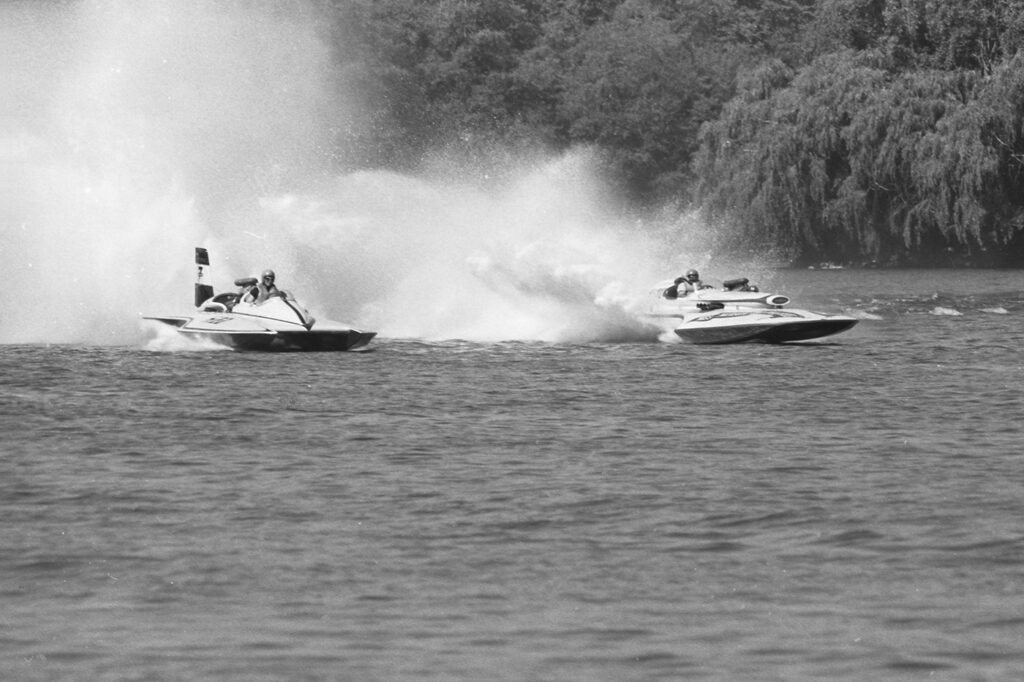
Earl Wham, in Miss Merion Bluegrass, on the right, racing against George Babcock in Record 7. Photo from the Bob Carver collection.
What name was on the boat then?
Miss Merion Bluegrass.
That was its first race?
First race. The Merion Bluegrass won its first race.
Where did that name come from?
Well, Fred raised Merion Bluegrass. So we got Merion Bluegrass to sponsor us going down to Florida for the International Grand Prix. We built a 327 supercharged engine to go to Florida for the International Grand Prix. The way we got the Merion Bluegrass name was the Merion Bluegrass Association sponsored us going to Florida, and they gave us so much every race that I ran the Merion Bluegrass all the time. Helped make it possible.
So Fred was responsible for helping get that sponsorship.
Yes, and Fred a super machinist who made all the racing possible, and all the good engines. He could build anything, and he did. Well, to make a long story short, we went down to Florida. In the qualifying heat, we were in a deal like over here; there was a long field full of boats and the boats couldn’t get out until they fired the five minute gun. Then they couldn’t get the boats out so they extended it to a 10-minute gun, only we didn’t know that. We were on the course. We had no way of knowing it. So the race goes off and I’m running in the last lap, coming around the last corner, right in the middle, and it quits. Your first thought is, “Somebody’s going to run over me,” you know. There were 10 boats in the race, supercharged, fastest boats from all over the world. So I stand up to wave my arms to tell ‘em that I’m dead in the water. I look back and here’s the second place boat coming out of the turn and he’s the fastest boat in the world, Ray Gassner’s Sunshine Baby IV. The announcer on Wide World of Sports says, “Watch this yellow boat, people.” They’re taking pictures from a helicopter. He comes up alongside of me there with a full roostertail and then just as he gets ahead of me it’s like a hand reaches out and grabs the front of that Merion, lifts it up a foot and-a-half in the air. Shoots the roostertail 50 feet in the air and just shoots by, down to the start-finish line. And it dies. Coasts across the finish line. That’s when the announcer went wild. That was the qualifying heat, but they showed the whole heat on Wide World of Sports. The Merion Bluegrass Association went ape over that because of all the advertising they got. Four or five minutes, you know. The Bluegrass was the same color as it is now, yellow and peacock. We painted it before we went down there and that’s the way it was all the rest of its life, until I quit racing. Anyway, in the main race I was a half-lap ahead and the motor blew up. I was running the thing 10,000 rpm and it just stretched the bolts right to a point, like taffy, and they broke throughout.
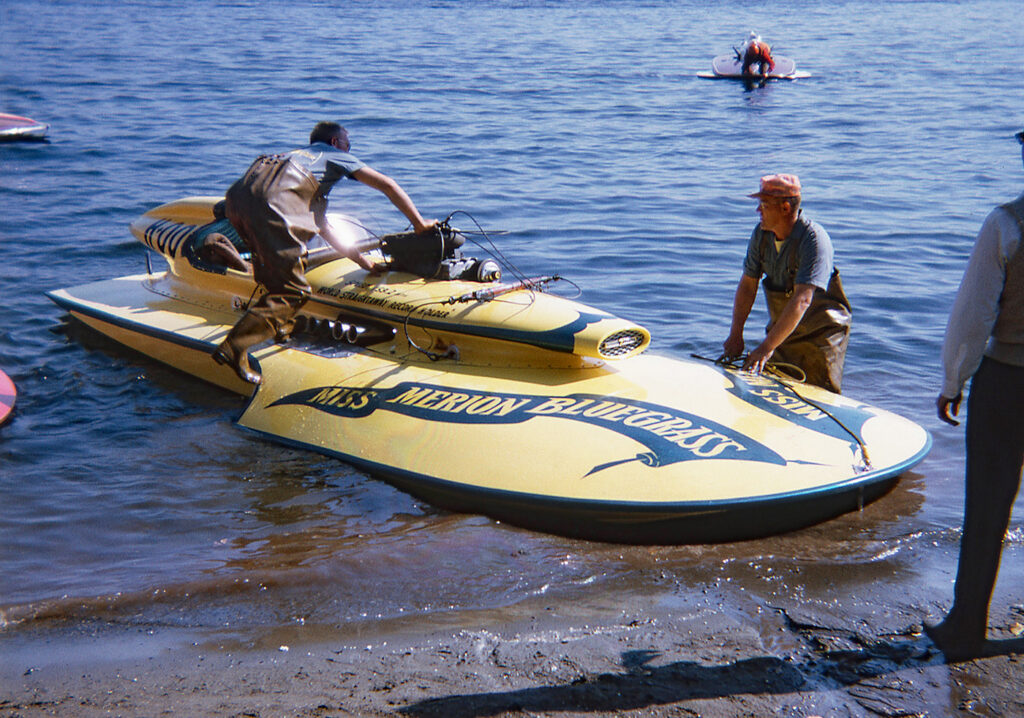
Miss Merion Bluegrass at Lake Sammamish, near Seattle, in September, 1968. Photo by Randy Hall.
After you came back from Florida, what did you do in racing?
We brought the Bluegrass back and re-engineered it. Figured out what we had to do to make it live. We ran that two more years and won a lot of races with it. Then we put a 427 in there and I went down to Lincoln City, Oregon, and broke the world straightaway record there. Then we went back and won the International Grand Prix with it against 150 boats from all over the world. In the meantime, we were winning almost every race in the Northwest. Finally, Seattle Drag & Ski had a Rainier Challenge Cup race to win $1,000. We brought the boat, went to sign in, they said the 7-Litres aren’t on the schedule. I said, “What do you mean?” “You’re not on the schedule. You can’t run. You have to run with the supercharged drag boats in the drag racing, that’s the only thing you can run in.” So they had a drag course set up. I went back to my mechanic who came with me. I said, “We can’t run in the Rainier Challenge Cup for $1,000.” He said, “We can’t? Why not?” I said, “Well, they didn’t put me on the schedule.” So we tore the gear box apart, put the lowest set of gears we had in it, put the smaller prop we had, and we made a run on the drag course. I went 138 miles an hour on that standing start quarter. There were six Blown Fuel Hydros there that day.That’s the ones with the engines in the back. They were running 160 to 170 miles an hour in the quarter.
Yes.
Well, to make a long story short, they fiddled around and fiddled around. They started to run the big boats last and the water got a little rough. The Merion still ran 138. The first guy that went out with me pulled me out of the hole about two boat lengths, hits a little roller, a whitecap, and threw himself out on the deck. Tried to pull himself back in the boat. In the meantime, I’m going straight by. I beat him. Two more of them go out against each other and one of ‘em gets himself thrown out of the boat in the whitecaps. I’m going out against the final guy and I beat him to the end. I win the Chuck Skaggs Memorial drag race on Lake Sammamish. Here’s the kicker. To win the Rainier Challenge Cup was $1,000. To win the Chuck Skaggs Memorial drag race was $2,000 and a seven-foot trophy. Needless to say, I had a real smirk on my face when I went over and picked up that check. And that was the last race I ran in the Merion.
What year was that?
October 21, 1971. And then I had won many, many races in between with the Merion.
There’s a story that the boat was stolen one time.
Yeah, that was in Florida after we won the Grand Prix.
Can you share what happened?
Well, I can tell you all about it. Lou Nuta was an Italian. He liked the boat because it had an Italian cowling on it. He thought it was an Italian boat. I’m half-Italian so that kind of made me passable in his book. Anyway, he allowed me to work on the boat in his garage. We were getting ready to leave the next morning. We’re going to leave real early, you know, 5:00 in the morning, so we can drive all day up the Sunshine parkway in the sunlight. So we take the boat out of his garage and take it down to the motel. I throw two safety chains around the steel pole there and lock ‘em up. Get up the next morning and all that’s laying there is the lock, cut with bolt cutters. The boat’s gone, trailer and boat. Well, I call the police. They say they’ll be out. This is 6:30. Hell, I wait until 8:00. No one shows up so I call the Mayor’s office. Mayor says, “Well, I’m just a figurehead, you’ll have to get the City Manager.” So he gives me his number. I call him and he says, “Well, I probably can’t do you any good because they stole it in the city and it’ll be out there in the Everglades somewhere stripped.” I said, “What do you mean?” He says, “Well, that’s where everything ends up. We can’t even go in there unless there are two of us. One of us might not come out.” I said, “Well, here I am, you know, front page of your Miami Herald. And there it was, on the Sports page, “Speedy racing boat won the International Grand Prix,” and then on the front page next day, “Speedy racing boat stolen.” Yellow and all the color and all that. He says, “Well, maybe you ought to call the Governor.” I said, “Well, I don’t know the Governor.” He gave me a number and I got the Governor’s aide. The Governor’s aide says, “Well, we can’t do nothin’ for you. We’ll see what we can do with the Coast Guard.” So I step outside my motel there, about a mile from the airport, and it looked like World War III taking off. All of a sudden helicopters took off out of the area there, four or five of them and they spread out going every direction. I didn’t think anything of it. An hour later I get a phone call that they’ve located my boat. They’re hovering over it. It’s in the Everglades and they’re sending a wrecker to get it. I called Louie (Nuta) to tell him what happened. He says, “Where you at?” I told him I’m at the motel. He says, “I’ll come over and get you.” So he comes over in his limousine. Then he stops by the courthouse and he gets a judge out of his chambers and then he gets the city detective and the sheriff in charge of theft. There are six of us in the limousine. We drive out there. They’re draggin’ the boat out of the Everglades. The motor’s gone. Sheriff told me, “Well, you’ll never get any of that back.” I said, “What do you mean?” He says, “Well, we’re never able to recover that. We lose five or six cars a week getting around here and all. You know, everything goes north. U-Haul trucks.” Well, that’s pretty sad about that thing. Louis comes over and he says, “Don’t worry. Personally, I’ll take care of this.” In the mean time, the sheriff’s detective and all of them went over and got some pictures of the boat. Probably said something about I wouldn’t get out of there for two or three days. Two hours later the boat was turned loose in my deal. But Louie said, “Don’t worry, son, I’ll personally take care of this.” Six weeks later I get a phone call, “Where do I want the motor delivered?” It had been left on the freeway with a note, “This is all of the pieces we know where they’re at. Please don’t bother us anymore.” The only thing missing was one rocker arm and the exhaust pipes.
Hmm, wow.
I figured those were sinking below the ground. They took them off and threw them in the damn river or some place they couldn’t get them, because nobody could use those pipes for anything. And the rocker arm just got lost. Everything else was there. Then I talked to a guy from there, Jumpin’ Jack Flash, he said, “For two years after your boat was stolen, there was a boat like that with a number 6 on it. It looked like it might be a racing boat. It was like it was electrified with a thousand volts and would electrocute you immediately if you even touched it. It was persona non grata to touch any racing boat from then on.” And the story I got was they found the supercharger by the number that I gave them on a guy’s boat at a (car) drag race. Took that off, unbolted the parts, took five gallons of gas, poured it on his race car and lit it on fire. They asked him where he got the supercharger. He said it was for cash. He said, “Well, you better find out a little more information than that or the next fire you see will be your house with you in it.”
We’ve heard part of that story.
Well, that’s how it happened.
To move on, you drove an Unlimited for Bob Fendler, the U-19 Atlas Van Lines.
Yeah, I was no good at that.
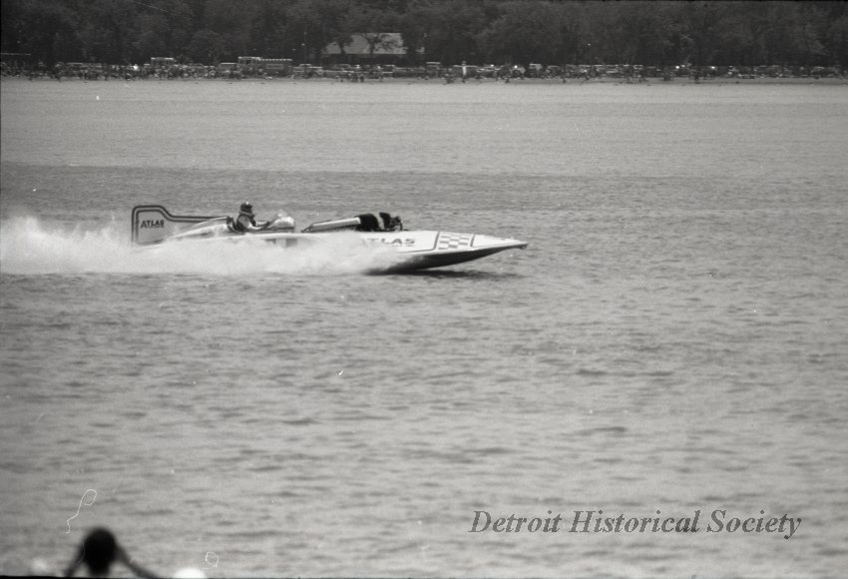
Earl Wham driving the U-19 Atlas Van Lines Unlimited Hydroplane, from the Detroit Historical Society.
You didn’t seem to have a lot of fun.
I didn’t like the boat. I talked to Jim Lucero today (day the interview was done – Ed.). He was working on the boat. He wasn’t the crew chief, another guy was. But the boat didn’t ride right. It would get to porpoising in the corners. They’d say, “Try to get through it” and I’d try to get through it and pretty soon it would be kicking the water over the nose and dumping it on me. About the third race I was in, that happened, I just called ‘em up and told them to get somebody else to drive it, I wasn’t going to die. I didn’t want to be the first one to arrive at the scene of the accident.
Did they help you learn how to start the engine? Was it different technology?
Naw, it was no problem at all. Stepped right in there. They ran me through the starting procedure one time and I caught on to it real easy. I didn’t have any trouble with that part. The part I had was I figured the boat was going to dig in and do something serious and I didn’t want to be there when it happened. Plus I had just gotten married and every time I’d come back from a race my wife had been crying all weekend. You can only take so much of that. Either had to get rid of her or the boat. I decided I wanted to keep her.
Your first boat was a cabover and then you drove conventionals. Did you have a preference?
It didn’t make any difference where the driver sits. I liked to be behind the engine because I could see what was happening then.
Well, when you look back at inboard racing today, compared with how it was when you were involved, what are your thoughts?
I love the boats, love being around them, but what they’ve done, APBA has got these new starting procedures. They’re the deadest things in the world as far as I’m concerned. They’ve got to get ‘em on a staggered start like they do a sprint race on a track. You gotta have the outside boat have a couple hundred feet less distance to the starting line than the inside boat. Mulling around at two miles an hour trying to get the inside lane and then every time you make a turn, to make the outside boat go three times as fa,r doesn’t do anything for the spectators at a boat race, in my opinion. I love the boats, I love what they’re doing and I love the feel, but I don’t like what their starting procedures do.
Well, we’ve covered a lot. Thanks for your time and the conversation.

The late, great Earl Wham, courtesy of Gleason Racing Photography
For more on Earl Wham, see Chuck Stewart’s article in the The Spokesman-Review, “Area motorsports legend Earl Wham dies at 87”
Featured Articles



